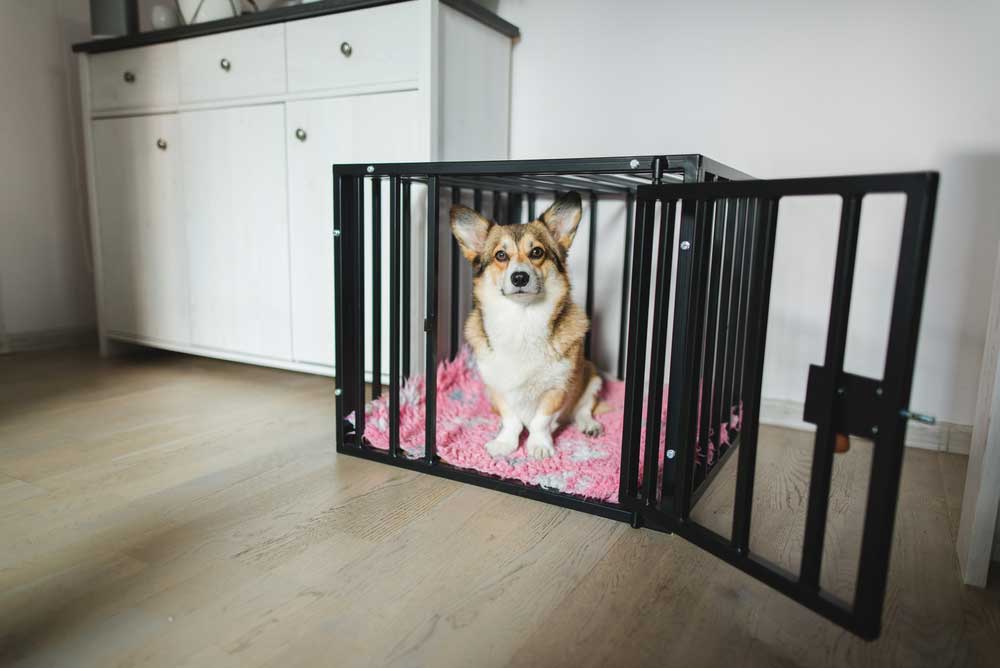
How to Crate Train a Puppy
Are you a dog lover who just brought home a new puppy? As exciting as it is to bring home a new member to the family, it can also be stressful. Now that you are a dog parent, it’s important to learn proper training techniques to make both you and your pup’s lives easier. Although crate training a puppy may seem daunting at first, we’ve broken down the process into a simple yet effective approach.

What Is Crate Training?
You may have heard of crate training before, or the term might be a new one for you. Whichever the case, you are in the right place to start the journey. Crate training uses a step-by-step process to slowly teach your pup to accept the crate as a familiar, safe, and comfortable living space. The idea uses the dog's natural instincts as an advantage, as they are den-dwelling creatures.
However, there is a right and a wrong way to go about crate training. If done incorrectly, your dog can feel trapped and frustrated. Be sure to always listen to your dog’s needs and be patient. Crate training can take anywhere from weeks to months, depending on your dog’s age, temperament and past experiences. When it comes to crate training, slow and steady wins the race.
Benefits of Crate Training

A common misconception of crate training is that an owner is “trapping” their dog. New parents might look at their pup in the crate and feel guilt when they see their pup is confused. However, as long as you are attentive to your dog’s needs, crate training your puppy is actually beneficial and there is no need to feel guilty. Below are some of the benefits:
- Encourages potty training. Little by little, a dog will gradually start to build a tolerance to going potty. Most puppies will not soil where they sleep. Keep a close eye and be sure to let them out when they need to go.
- Helps streamline the house training process. Not only with potty training, but it also prevents other misbehaviors. It will prevent your dog from chewing up your things or getting into food when you are not around.
- Providing your puppy space of their own. Introducing a crate provides your puppy with comfortable personal space. They can use this as a recovery zone when they feel stressed or overstimulated.
- Helps introduce your dog to strangers. Your dog may need time to warm up to new people, especially if you are having a group over. Leave the crate door open for them and if they feel uncomfortable, they can always go inside. Once they are ready, they will come out of their crate to say hi at their own pace.
- Lastly, it makes travel easier. A crate is an excellent way for your dog to tag along on road trips with you, as you are providing something familiar in an otherwise new environment.
How To Get Started
Crate training is a time-tested way to keep your pup secure and safe when introducing them to a new home. Now that you have an idea of the benefits, let’s get into the process.
Choose the Right Puppy Crate

Do not underestimate the importance of choosing the right crate. Crates come in plastic, fabric (on a collapsible frame), and metal (collapsible) pens. Whichever you choose, the crate should be large enough for your dog to stand up and turn around in. Keep in mind that your pup will grow quickly, so choose a crate that will accommodate their adult size. If this means the crate is too big for its puppy size, opt for a divider. This ensures the puppy will have an optimal and adjustable room as they grow. You don’t want the crate to be too big to where they can go potty on one end and sleep on the other.
Introduce Your Puppy to the Crate
Crate training your puppy is simple in theory, but in practice may be challenging depending on your dog. Ideally, pups should begin their crate training around eight weeks of age. The most important part of the training is to make the crate an inviting space. Place the crate in a room where the family spends their time most. Keep a soft bed or blanket in the crate, along with extra chew toys. Leave the door open when you are home and let the puppy explore the crate as they please. In the beginning, you can encourage your puppy into the crate by dropping some treats inside, near to the door. If your puppy refuses to enter the crate, do not force anything. Patience is key throughout the process. Your pup will go at their own pace. Below are our other tips for throughout the training process.
Crate Training Tips
- Once your pup starts entering the crate on their own, praise them and offer treats a reward for making the choice.
- As they get comfortable entering, you can start placing their toys and food further back in the crate.
- The key is to teach your puppy to associate the crate with positive emotions. You want every interaction with the crate to be a positive one. The crate should never be used for punishment.
- Eventually, some puppies will start sleeping in the crate out of curiosity. This is a good signal that indicates they feel comfortable and safe in their crate.
- It is a good idea to encourage your puppy to eat in their crate when they are ready. Again, this creates a positive association with the crate. Start by placing their meals near the crate. If they are comfortable, you can move their food inside.
- Once your pup is comfortable eating in the crate, close the door for the first time and watch their reaction. If they don't react and continue feeding, open the door immediately after they are done with the meal. Leave the door closed for longer with each successive feeding.
- If your puppy starts to whine, let them out. Lower the time you leave the puppy in the crate in the next feeding.

How to Go About Leaving the House
When your puppy starts eating their meals in the crate and shows no signs of anxiety or fear, you are making steps towards being able to leave your puppy home alone. However, as with the rest of the process, you must take baby steps. Start off by extending its time in the cage while you're at home.
Step-by-step:
- Encourage your pup into their crate. You can give voice commands or clues while pointing inside the crate and holding a treat in your hand
- Close the door and praise the puppy when they enter the crate. Now is when you can give them their treat.
- Quietly sit near the crate for 5 to 10 minutes. When they elapse, walk into another room for a few minutes. Walk back and sit close to the crate for a few more minutes before letting the puppy out.
- Repeat the process a few times a day while gradually increasing the time they spend in the crate, as well as the length of time you spend out of sight.
When your puppy is accustomed to the crate and can be left alone for 30 or more minutes without being anxious, you can start actually leaving the house for short periods. You have to be patient; this part of the process can take several weeks.
Plan Ahead, Not in the Moment
Try to vary the crating routine before you leave the house. Crate training your puppy anywhere from 5 to 20 minutes before actually leaving. You also will want to avoid making prolonged and emotional departures. When your puppy enters the crate, offer some praise and a treat, then leave quietly. The same applies to when you return. Reward them calmly but don’t overwhelm them, as this can increase your puppy's anxiety any time you're away.

Progress isn’t linear. Keep crating training your puppy for short periods while you are home from time to time to disassociate crating from being left alone at home. Here are some last few tips for the tail end of the training process:
- Don’t leave your pup in the crate for too long. Puppies under the age of 6 months shouldn’t stay in a crate for more than three to four hours at a time. For one, their bladders simply are not strong enough yet. Second, they are not yet meant to be alone for that long in general, as they will start to have anxiety and intense loneliness.
- When they are accustomed to their crate, be sure not to bother them when they go inside. This is an indication they need alone time.
- Crate your dog until they are able to be alone in the house without any accidents or misbehavior. Then, you can graduate your dog from a crate to an enclosed area of your home.
- Lastly, your dog should not spend most of their time in a crate. While it should be a comfortable environment, your dog still needs mental and physical stimulation throughout the day.
Puppy Crate Training Schedule
Here is an example of an effective crate training schedule for your pup. This is just one of many examples, and there is not only one path to success. Keep in mind that this schedule may be a bit too much time in the crate if your dog is not yet comfortable. Always adjust to the needs of your and your dog.
-
Wake up:
- First thing in the morning, take your puppy out to go to the bathroom. Now is when you can also offer them their first treat of the day. Allow time for digestion, another potty break, and play time if needed. This would be a great time for a walk or the park! After about an hour or so, encourage your pup back into the crate. If this is successful, sit nearby until they calm down or nap.
-
Morning/midday playtime:
- Let your puppy out to go potty and play. If they haven’t already, you could also walk your pup or take them to the park at this time. Young dogs tend to have a lot of spirit and energy, but they gas out quickly. They might want another walk which is great, but be attentive when it seems as though they are getting tired.
-
Afternoon crate training:
- After some good play time and plenty of potty breaks, you may be able to get in some more crate training. Invite your puppy back into their crate and see how they feel. Don't ever close the door if your puppy is uncomfortable.
-
Evening meal and bonding:
- Dinner time! Your pup may or may not be out of their crate at this time, either of which is fine. If they do not want to eat in the crate, try placing their bowl near the crate. After dinner, be sure to get in some more play time. Light movement after a meal helps their digestion. They will also be able to settle down easier later.
-
Bedtime:
- You may need to keep the crate in your hallway or bedroom for the first few nights to listen if your pup whines or needs to go potty. Only do this when they are already accustomed to the crate in the daytime. Be prepared that there might be a lot of whining the first few nights as they are adjusting. Do not punish them simply for whining, they are just trying to get used to the process.

Join Our Pack
Follow us @NaturVet on social media to fill us in on any tips we might have missed. And, check out the rest of NaturVet.com. We’ll keep you up to date on all our latest pet resources, supplements, tips and tricks, and more – everything you need to be the best pet parent possible!






